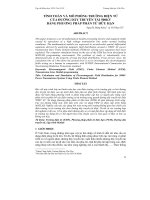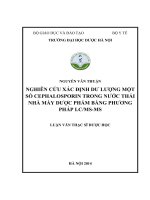NGHIÊN CỨU ĐẶC TÍNH ĐIỆN TỪ TRƯỜNG ĐAN XEN TRONG HỆ THỐNG DÂY DẪN NHIỀU SỢI BẰNG PHƯƠNG PHÁP PHẦN TỬ HỮU HẠN
Bạn đang xem bản rút gọn của tài liệu. Xem và tải ngay bản đầy đủ của tài liệu tại đây (1013.92 KB, 9 trang )
<span class='text_page_counter'>(1)</span><div class='page_container' data-page=1>
<b>STUDY OF ELECTROMAGNETIC BEHAVIOR IN MULTICONDUCTOR </b>
<b>SYSTEM BY FINITE ELEMENT METHOD </b>
NGHIÊN CỨU ĐẶC TÍNH ĐIỆN TỪ TRƢỜNG
ĐAN XEN TRONG HỆ THỐNG DÂY DẪN NHIỀU SỢI
BẰNG PHƢƠNG PHÁP PHẦN TỬ HỮU HẠN
<b>Nguyen Duc Quang </b>
<i>Electric Power University </i>
<b>Abstract: </b>
This paper involves modeling and calculating the mutual electromagnetic characteristics in a
multiconductor system using finite element method and equivalent energy equations. The approach
is applied on a real three phase shielded cable. The finite element model of the cable is presented
for calculating the mutual parameters which depend on the frequency. The high frequency
phenomenas, the skin and proximity effect, are well studied.
<b>Keywords: </b>
<b>Multiconductor, electromagnetic field, magnetodynamic, Maxwell’s equations, finite element method. </b>
<b>Tóm tắt: </b>
Bài báo đề cập đến việc nghiên cứu các đặc tính điện từ trường đan xen trong một hệ thống đa dây
dẫn bằng phương pháp phần tử hữu hạn kết hợp việc giải các phương trình năng lượng. Phương
pháp nghiên cứu được trình bày chi tiết và áp dụng tính tốn chi tiết một hệ thống đa dây dẫn cụ
thể - cáp ba pha có đai bảo vệ. Các giá trị tương hỗ giữa các dây dẫn, cũng như các hiện tượng xuất
hiện ở tần số cao như hiệu ứng bề mặt và hiệu ứng gần được xác định rõ nét.
<b>Từ khóa: </b>
Hệ thống đa dây dẫn, điện từ trường, điện động, hệ phương trình Maxwell, phương pháp phần tử
hữu hạn.
<b>1. INTRODUCTION7</b>
Multiconductor systems are frequently
used in energy transmission such as
overhead lines and cables. The mutual
electromagnetic effect is extremely
7 <sub>Ngày nhận bài: 28/8/2017, ngày chấp nhận </sub>
đăng: 20/9/2017, phản biện: TS. Trần Thanh
Sơn.
</div>
<span class='text_page_counter'>(2)</span><div class='page_container' data-page=2>
Electromagnetic Interference (EMI). In
power system, this high level of emission
can produce the high frequency
disturbance which propagate over the
power cables [1,2]. In order to analyze the
influence of transmission multiconductor
system on the EMI level, it is necessary to
precisely model the behavior of this
system in the frequency domain.
However, there are some difficulties in
modeling of system due to several factors
[3,5]. Firstly, the properties of materials,
thicknesses of insulation and shielding are
not fully known. Secondly, electrical
wires and frame are twisted, sometimes in
opposite sense. These physical parameters
are insufficient to model a multiconductor
system in the frequency domain;
therefore, it is necessary to take into
account the electromagnetic phenomena
such as the skin effect and proximity
effects [1,2,4]. To correct model, both of
these effects are highly dependent on the
characteristics of the materials and on the
geometry; thus, the finite element method
is proposed to use [4,7]. The number of
simulations by finite element method will
vary according to the number of
conductors in the multiconductor system.
Each simulation will provide an energy
value that will allow us to determine the
lumped parameter (resistance and
inductance) matrices. Moreover, these
simulations will be performed for several
frequencies to capture the evolution of the
skin and proximity effects.
<b>2. METHODOLOGY </b>
In this section, the electromagnetic
formulations used to calculate the lumped
parameters are introduced. Based on
energy method, the seft and mutual values
are obtained from the finite element
model [8].
<b>2.1. </b> <b>Finite </b> <b>Element </b> <b>Method </b> <b>and </b>
<b>Formulations </b>
<b>Finite Element Method </b>
The finite element method (FEM) is a
technique for the numerical resolution of
partial differential equations. This method
is powerful, general, robust and widely
used in engineering.
<b>Figure 1. Decompostion of a studied object </b>
<b>to finite elements </b>
In reality, the FEM solves the weak form
of the partial differential equations by
using a mesh which serves as support for
the interpolation functions.
The weak formulation is also called
variational formulation. This formulation
can be defined by considering a
<i>differential operator R and a function f </i>
<i>such as finding u on Ω checking </i>
<i>Ru</i> <i>v</i> <i>fv</i> for any adapted function <i>v</i>.
</div>
<span class='text_page_counter'>(3)</span><div class='page_container' data-page=3>
facets and the volumes.
Solving the final electromagnetic
equations in a complex object, such as a
multiconductor system, is extremely
difficult. Therefore, the author used the
finite element method and solved the
problem by using its numerical tool as
Salome software [6]. This is a software
which provides a generic platform for
numerical simulation. It is based on an
open and flexible architecture made of
reusable components. Salome can be used
as standalone application for generation
of Computer-aided design (CAD) model,
its preparation for numerical calculations
and post-processing of the calculation
results. Salome can also be used as a
platform for integration of the external
third-party numerical codes to produce a
new application for the full life-cycle
management of CAD models.
In this study, the value of the capacitance
matrix is supposed not to be frequency
dependent and not to be examined.
However, for the resistance and
inductance matrices which vary with the
frequency, the two magnetodynamic
potential formulations are used [9,10].
<b>Magnetodynamic problem </b>
As mentioned above, the purpose is to
determine the resistance and inductance
matrices which depend on the skin and
proximity effects. These resistance and
inductance matrices are calculated in
function of the frequency by solving the
magnetodynamic formulations.
The magnetic vector potential A and the
electric scalar potential j are identified
such that the magnetic field B and vector
A are related by B=curlA and the electric
field E is equal to E=jA-gradj.
Combining the previous equations with
the Ampere’s law (curlH = J, H as the
magnetic field and J as the current
density) and with the behavior laws
(B=H and J=E with as the
permeability and as the conductivity),
the partial differential equation to be
solved is:
1
(<i>j</i> )
j
<b>S</b>
<b>curl</b> <b>curlA</b> <b>J</b> <b>A grad</b> (1)
The boundary conditions indicated on B
(B.n=0) and E (E×n=0) are imposed on
the application of A×n=0 on ΓB and
A×n=0 and j=0 on ΓE respectively.
There is another potential formulation.
The electric vector potential formulation
T and the magnetic scalar potential
formulation Ω are introduced such that:
= <b><sub>S</sub></b>+ <b><sub>ind</sub></b>= <b><sub>S</sub></b>+
<b>J J</b> <b>J</b> <b>curlT</b> <b>curlT</b> (2)
Where the source term JS=curlTS and the
unknown term Jind=curlT. Consequently
the equation to solve is given by a
conductive part
1
<i>j</i>
<b>S</b> <b>S</b>
<b>curl</b> <b>curlT</b> <b>curlT</b> <b>T</b> <b>T</b> <b>grad</b>
(3)
</div>
<span class='text_page_counter'>(4)</span><div class='page_container' data-page=4>
<b>2.2. </b> <b>Determination </b> <b>of </b> <b>impedance </b>
<b>matrices </b>
Based on the calculation of the energy,
Joule losses and magnetic energy, the
values of R and L matrices can be found.
In general, if the conductors are flown by
an electric current, the Joule losses and
the magnetic energy are expressed as
follows :
2
1 , 1;
2
1 , 1;
1
2
<i>n</i> <i>n</i>
<i>Joules</i> <i>i</i> <i>ii</i> <i>i</i> <i>j</i> <i>ij</i>
<i>i</i> <i>i j</i> <i>i j</i>
<i>n</i> <i>n</i>
<i>mag</i> <i>i</i> <i>ii</i> <i>i</i> <i>j</i> <i>ij</i>
<i>i</i> <i>i j</i> <i>i j</i>
<i>P</i> <i>I R</i> <i>I I R</i>
<i>W</i> <i>I L</i> <i>I I L</i>
<sub></sub> <sub></sub>
<sub></sub> <sub></sub>
<sub></sub> <sub></sub> <sub></sub> <sub></sub>
<sub></sub> <sub></sub>
(4)
<i>where Rii, Lii </i> are respectively the self
<i>resistance and inductance of conductor i; </i>
<i>and Rij, Lij</i> are the mutual reristance and
<i>inductance between conductor i and </i>
<i>conductor j. </i>
To take into account the evolution of the
resistance according to the skin and
proximity effect, the simulations must be
carried out at several frequency values. It
should be noted that self resistance values
corresponds to Joule losses in the three
conductors when only one is supplied.
For example, a simple two-conductor
system can be seen as below:
R12
L12
u1
R11
L11
R22
L22
C10
C20
u2
i1
i2
C12
<b>Figure 2. The mutual relationship </b>
<b>in the two conductor system </b>
In the magnetodynamic problem, the
relaitonship of resistance and inductance
between the condutors can be defined as
follows :
11 12 11 12
21 22 21 22
;
<i>R</i> <i>R</i> <i>L</i> <i>L</i>
<i>R</i> <i>L</i>
<i>R</i> <i>R</i> <i>L</i> <i>L</i>
<sub></sub> <sub></sub> <sub></sub> <sub></sub>
(5)
<i>where R</i>11<i>, L</i>11, <i>R22, L</i>22 are respectively
the self resistance and inductance of
<i>conductor 1 and conductor 2; and R</i>12<i>, L</i>12
<i>(or R</i>21<i>, L</i>21) are the mutual resistance and
inductance between conductor 1 and
<i>conductor 2. R</i>12 represents the effect of
proximity of conductor 1 to conductor 2
<i>and L</i>12 is the mutual inductance between
these two conductors.
The energy equations (4) in this case
become:
2 2
1 11 2 22 1 2 12
2 2
1 11 2 22 1 2 12
2
1 1
2 2
<i>Joules</i>
<i>mag</i>
<i>P</i> <i>I R</i> <i>I R</i> <i>I I R</i>
<i>W</i> <i>I L</i> <i>I L</i> <i>I I L</i>
(6)
The approach principle is the variation of
input currents in FEM model to calculate
the energy equations. The findings of
PJoules and Wmag values are based on this
FEM model.
</div>
<span class='text_page_counter'>(5)</span><div class='page_container' data-page=5>
<b>3. CASE STUDY </b>
<b>3.1. Geometry and parameters </b>
This cable has three cores, and each
conductive core consists of 61
non-insulated copper wires. Each core is also
surrounded by a semi-conductive tape and
a XLPE insulation, and then there is the
jam, the sealing sleeve, the armature as
well as the outer sheath as being shown in
Figure 3.
<b>Figure 3. Configuration of the cable </b>
<b>Table 1. Parameters of the cable </b>
As a part of the study, all of the copper
strands are assimilated to a uniform
section. This assumption is valid as far as
the strands are not insulated from each
other and are wrapped by an insulating
sheath which contributes to increasing the
contact areas. Each conductor is
surrounded by semiconductor layers. As a
part of this work, these semiconductor
layers are consided playing a role of
insulation. Therefore, they are modeled in
the case of magnetodynamic model by a
non-conductive and non-magnetic
material in the case of electrostatic model
by a dielectric material r = 2,4
corresponding to the XLPE insulation
surrounding the conductor. The studied
system is simulated for 1 m of length.
<b>3.2. Mesh </b>
Since there are three conductors and
conductive armature (Figure 4), the linear
parameters to be determined will be
expressed in a matrix form of around 4*4.
<b>Figure 4. Representation of conductive parts </b>
<b>in modeling cable </b>
</div>
<span class='text_page_counter'>(6)</span><div class='page_container' data-page=6>
equivalent circuit of this cable is
represented by the coefficients of the
matrices [R] and [L].
Instead, the magnetodynamic model will
present well the distribution of induced
currents of cable. The calculations are
carried out with the amor connection
condition as in Figure 6.
This figure shows the equivalent circuit of
the multiconductor system. The values
R11, R22, R33, Ra and L11, L22, L33, La are
respectively the resistance and inductance
of conductor 1, 2, 3 and of the amor.The
values R12, R13, R23, R1a, R2a, R3a are
respectively the mutual resistance
between the conductors as well as
between a conductor with the amor of
cable. The rule of inductance is similar.
The Figure 6 (bottom) represents the
equivalent circuit in case of forward
current in conductor 1 and back current in
two conductors 2 and 3. In this case, the
amor of cable is open circuit (ia = 0).
<b>3.3. Solution and Results </b>
The distribution of the induced current in
cable at f = 1 kHz is well presented in the
Figure 7.
<b>Figure 7. Density of current in cable (A/m2) </b>
This result is corresponding to the case of
the current flowing through the conductor
1. The distribution of current in conductor
1 is according to the skin effect. At the
same time, the induced currents are
produced in the conductors 2 and 3. This
is the proximity effect that occurs at high
frequency in the multiconductor system.
</div>
<span class='text_page_counter'>(7)</span><div class='page_container' data-page=7>
This proximity effect also appears on the
amor of cable. The Figure 8 shows that
the induced current is maximum at
position near conductor 1 and minimum
corresponding to the farthest distance
from the conductors.
Therefore, the high frequency
phenomenas like the skin effect and the
proximity effect in conductors and also in
amor of cable are clearly demonstrated.
Solving the problem magnetodynamic by
finite element method, value of Joules
losses and magnetic energy are obtained
according to frequency.
The equations (4) in this case become as
follow:
4 4
2
1 , 1;
4 4
2
1 , 1;
1
2
<i>Joules</i> <i>i</i> <i>ii</i> <i>i</i> <i>j</i> <i>ij</i>
<i>i</i> <i>i j</i> <i>i j</i>
<i>mag</i> <i>i</i> <i>ii</i> <i>i</i> <i>j</i> <i>ij</i>
<i>i</i> <i>i j</i> <i>i j</i>
<i>P</i> <i>I R</i> <i>I I R</i>
<i>W</i> <i>I L</i> <i>I I L</i>
<sub></sub> <sub></sub>
<sub></sub> <sub></sub>
<sub></sub> <sub></sub> <sub></sub> <sub></sub>
<sub></sub> <sub></sub>
(7)
Solving equations (7) by obtained energy,
values of resistance and inductance
depend on frequency. The parameters
variation of conductors (R11, L11) and
shield (R44, L44) as well as mutual values
between two conductors (R12, L12) and
between a conductor and shield (R14, L14)
are calculated and shown in Figure 9 and
in Figure 10.
The value of resistance increases and of
inductance decreases with the frequency
of source. In the frequency range [0;
100kHz], the calculated resistance is
relatively small. It is explained by a good
conductivity material of this study cable.
As the frequency increases, due to skin
and proximity effect, the resistance value
increases and the inductance decreases.
The difference of result obtained by A-j
and T-Ω formulations is also evident at
high frequency.
</div>
<span class='text_page_counter'>(8)</span><div class='page_container' data-page=8>
<b>Figure 10. Evolution of inductances depends on frequency </b>
The self values of resistance (Rii) and the
inductance (Lii) are always greater than
the mutual value between the conductors
(Rij, Lij). However, this mutual value
cannot be ignored and that is the
electromagnetic interference effect in
multiconductor system. It is perfectly
consistent with the theory when the skin
effect and the proximity effect appear to
produce the induced current in the
conductors of system.
<b>4. CONCLUSION </b>
This paper presents a method which is
applied to determine the impedances of a
multiconductor system according to the
frequency. The results can assert greatly
the phenomena HF of the cable: the skin
and proximity effect. There are two major
advantages when conducting this method.
Firstly, the modeling of proximity effect
in high frequency is carried out
successfully. Secondly, another benefit is
the introduction of the connection matrix.
The impedance of other configuration of
system according to frequency can be
determined by changing this matrix. This
method can be applied in calculation,
planning and operation of cable and
distribution network. Furthermore, this
approach will be help for the next study to
determine the resonant frequency of the
transmission system.
<b>REFERENCES </b>
</div>
<span class='text_page_counter'>(9)</span><div class='page_container' data-page=9>
[2] H. De Gersem, A. Muetze, “Finite-Element supported transmission line models for calculating
high frequency effects in machine windings”, IEEE Transactions on Magnetics, Volume: 48,
Issue: 2, p. 787-790, 2012
[3] Fabio Tossani, Fabio Napolitano, Alberto Borghetti, “New Integral Formulas for the Elements
of the Transient Ground Resistance Matrix of Multiconductor Lines”, IEEE Transactions on
Electromagnetic Compatibility, Volume: 59, Issue: 1, p 193-198, 2015.
[4] Gaspard Lugrin, Sergey Tkachenko, Farhad Rachidi, Marcos Rubinstein, Rachid Cherkaoui,
“High-Frequency Electromagnetic Coupling to Multiconductor Transmission Lines of Finite
Length”, IEEE Transactions on Electromagnetic Compatibility, Volume: 57, Issue: 6, p
1714-1723, 2015.
[5] Yan-zhao Xie, Jun Guo, Flavio G. Canavero, “Analytic Iterative Solution of Electromagnetic
Pulse Coupling to Multiconductor Transmission Lines”, IEEE Transactions on Electromagnetic
Compatibility, Volume: 55, Issue: 3, p 451-466, 2013.
[6] Salome software, The Open Source Integration Platform for Numerical Simulation,
htttp://www.salome-platform.org
[7] Xin Liu, Xiang Cui, Lei Qi, “Time-Domain Finite-Element Method for the Transient Response of
Multiconductor Transmission Lines Excited by an Electromagnetic Field”, IEEE Transactions on
Electromagnetic Compatibility, Volume: 53, Issue: 2, p 462-474, 2011.
[8] B. Gustavsen, A. Bruaset, J. J. Bremnes, et A. Hassel, “A Finite-Element Approach for
Calculating Electrical Parameters of Umbilical Cables”, Power Delivery, IEEE Transactions on,
vol. 24, no. 4, p. 2375 -2384, oct. 2009.
[9] Joseph A. Edminnister, “Theory and Problems of Electromagnetics”, Schaum’s outline series
McGraw-Hill, 1993.
[10] N. Ida, J. P. A Bastos, “Electromagnetics and Calculation of Fields”, Springer-Verlag New York,
1993.
<b>Biography: </b>
</div>
<!--links-->









